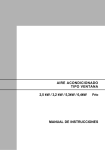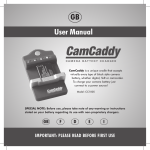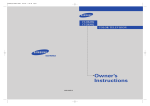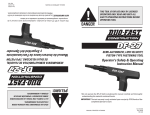Download RCA MR29410 User's Manual
Transcript
1577575A Cover 11/14/01 4:18 PM Page 1 Television User’s Guide Changing entertainment. Again. Please read this manual before using this product for the first time. TOCOM 15775750 Model: MR29410 1577575A Inside 11/15/01 9:53 AM Page 1 Warning! Important Safety Instructions CAUTION RISK OF ELECTRIC SHOCK DO NOT OPEN CAUTION: TO REDUCE THE RISK OF ELECTRIC SHOCK, DO NOT REMOVE COVER (OR BACK). NO USER SERVICEABLE PARTS INSIDE. REFER SERVICING TO QUALIFIED SERVICE PERSONNEL. This symbol indicates high voltage is present inside. It is dangerous to make any kind of contact with any inside part of this product. This symbol alerts you that important literature concerning operation and maintenance has been included with this product. ~ POWER CONSUMPTION: 100-240V 50/60 Hz 120 W (for model MR29410) Note to CATV system installer: This reminder is provided to call CATV system installer’s attention to Article 820-40 of the National Electrical Code, that provides guidelines for proper grounding and, in particular, specifies that the cable ground shall be connected to the grounding system of the building as close to the point of cable entry as practical. Caution: To prevent electric shock, insert the plug fully into the electrical outlet. To prevent damage which may result in fire or electric shock hazard, do not expose this appliance to rain or moisture. 1577575A Preface 11/15/01 10:42 AM Page 1 Important Safety Information Always be careful when using your television. To reduce the risk of fire, electrical shock, and other injuries, keep these safety precautions in mind when installing, using, and maintaining your machine. • Read all safety and operating instructions before operating your TV. • Keep the safety and operating instructions for future reference. • Heed all warnings on the TV receiver and in the operating instructions. • Follow all operating and use instructions. • Unplug the TV receiver from the wall outlet before cleaning. Use a damp cloth; do not use liquid or aerosol cleaners. • Never add any attachments and/or equipment without approval of the manufacturer. Such additions can increase the risk of fire, electric shock, or other personal injury. • Do not use the TV receiver where contact with or immersion in water is a possibility, such as near bath tubs, sinks, washing machines, swimming pools, etc. • Do not place the TV on an unstable cart, stand, tripod, bracket, or table where it can fall. A falling TV can cause serious injury to a child or adult, and serious damage to the appliance. Use only with a cart, stand, tripod, bracket, or table recommended by the manufacturer or sold with the TV. Follow the manufacturer’s instructions when mounting the unit, and use a mounting accessory recommended by the manufacturer. Move the TV and cart with care. Quick stops, excessive force, and uneven surfaces can make the unit and cart unsteady and likely to overturn. • Provide ventilation for the TV receiver. The unit is designed with slots in the cabinet for ventilation to protect it from overheating. Do not block these openings with any object, and do not place the TV receiver on a bed, sofa, rug, or other similar surface. Do not place it near a radiator or heat register. If you place the TV receiver on a rack or bookcase, ensure that there is adequate ventilation and that you’ve followed the manufacturer’s instructions for mounting. • Operate your TV receiver only from the type of power source indicated on the marking label. If you are not sure of the type of power supplied to your home, consult your appliance dealer or local power company. • Use only a grounded or polarized outlet. SAFETY 1 1577575A Preface 11/15/01 10:42 AM Page 2 • Protect the power cord. Power supply cords should be routed so that they won’t be walked on or pinched by objects placed on or against them. Pay particular attention to cords at plugs, convenience receptacles, and the point where they exit from the unit. • Unplug the TV from the wall outlet and disconnect the antenna or cable system during a lightning storm or when left unattended and unused for long periods of time. This will prevent damage to the unit due to lightning and power-line surges. • Avoid overhead power lines. An outside antenna system should not be placed in the vicinity of overhead power lines or other electric light or power circuits or where it can fall into such power lines or circuits. When installing an outside antenna system, be extremely careful to keep from touching the power lines or circuits. Contact with such lines can be fatal. • Do not overload the wall outlet or extension cords. Overloading can result in fire or electric shock. • Do not insert anything through the openings in the unit, where they can touch dangerous voltage points or damage parts. Never spill liquid of any kind on the TV. • Ground outdoor antennas. If an outside antenna or cable system is connected to the TV, be sure the antenna or cable system is grounded so as to provide some protection against voltage surges and built-up static charges. Section 810 of the National Electrical Code, ANSI/NFPA No.70-1984, provides information about proper grounding of the mast and supporting structure, grounding of the lead-in wire to an antenna discharge unit, size of grounding conductors, location of antenna discharge unit, connection to grounding electrodes, and requirements for the grounding electrode. EXAMPLE OF ANTENNA GROUNDING ANTENNA LEAD IN WIRE GROUND CLAMP ELECTRIC SERVICE EQUIPMENT ANTENNA DISCHARGE UNIT (NEC SECTION 810-20) GROUNDING CONDUCTORS (NEC SECTION 810-21) GROUND CLAMPS NEC — NATIONAL ELECTRICAL CODE POWER SERVICE GROUNDING ELECTRODE SYSTEM (NEC ART 250, PART H) • Do not attempt to service the TV yourself. Refer all servicing to qualified service personnel. Unplug the unit from the wall outlet and refer servicing to qualified service personnel under the following conditions: - when the power-supply cord or plug is damaged - if liquid has been spilled on the unit or if objects have fallen into the unit - if the TV has been exposed to rain or water - if the TV does not operate normally by following the operating instructions - if the TV has been dropped or the cabinet has been damaged - when the TV exhibits a distinct change in performance • If you make adjustments yourself, adjust only those controls that are covered by the operating instructions. Adjusting other controls may result in damage and will often require extensive work by a qualified technician to restore the TV to normal. • When replacement parts are required, be sure the service technician uses replacement parts specified by the manufacturer or those that have the same characteristics as the original part. Unauthorized substitutions may result in additional damage to the unit. • Upon completion of any service or repairs to this TV, ask the service technician to perform safety checks to determine that the TV is in a safe operating condition. 2 SAFETY 1577575A TOC 11/15/01 9:59 AM Page 1 CONTENTS Chapter 1: Your New TV . . . . . . . . . . . . . . .1.1 List of Features . . . . . . . . . . . . . . . . . . . . . . . . . . . . . . . . . . . . . . . . 1.1 Familiarizing Yourself with The TV . . . . . . . . . . . . . . . . . . . . . . . . 1.1 Front Panel Buttons . . . . . . . . . . . . . . . . . . . . . . . . . . . . . 1.1 Side Panel Jacks. . . . . . . . . . . . . . . . . . . . . . . . . . . . . . . . . 1.2 Rear Panel Jacks . . . . . . . . . . . . . . . . . . . . . . . . . . . . . . . . 1.2 Chapter 2: Installation . . . . . . . . . . . . . . . . 2.1 Connecting VHF and UHF Antennas . . . . . . . . . . . . . . . . . . . . . . . 2.1 Antennas with 300-ohm Flat Twin Leads . . . . . . . . . . . . . 2.1 Antennas with 75-ohm Round Leads . . . . . . . . . . . . . . . . 2.2 Separate VHF and UHF Antennas. . . . . . . . . . . . . . . . . . . 2.2 Connecting Cable TV . . . . . . . . . . . . . . . . . . . . . . . . . . . . . . . . . . . 2.2 Cable without a Cable Box . . . . . . . . . . . . . . . . . . . . . . . . 2.2 Connecting to a Cable Box that Descrambles All Channels . . . . . . . . . . . . . . . . . . . . . . . . . . . . . . . . . . 2.2 Connecting to a Cable Box that Descrambles Some Channels . . . . . . . . . . . . . . . . . . . . . . . . . . . . . . . . 2.3 Connecting a VCR. . . . . . . . . . . . . . . . . . . . . . . . . . . . . . . . . . . . . . 2.4 Connecting a Second VCR to Record from the TV . . . . . . 2.5 Connecting a Camcorder. . . . . . . . . . . . . . . . . . . . . . . . . . . . . . . . . 2.5 Installing Batteries in the Remote Control . . . . . . . . . . . . . . . . . . . 2.6 Chapter 3: Using the Remote . . . . . . . . . . . 3.1 How to Use Your Universal Remote . . . . . . . . . . . . . . . . . . . . . . . . 3.1 Remote Control Buttons . . . . . . . . . . . . . . . . . . . . . . . . . . . . . . . . . 3.2 Using the INPUT Button . . . . . . . . . . . . . . . . . . . . . . . . . . 3.3 Programming Your Universal Remote . . . . . . . . . . . . . . . . . . . . . . . 3.4 Testing the Remote . . . . . . . . . . . . . . . . . . . . . . . . . . . . . . 3.4 Programming the Remote to Control a VCR, Laserdisc Player, Satellite Receiver or Cable Box . . . . . . . . . . . . . . 3.4 Programming the Remote to Control an RCA Audio Device . . . . . . . . . . . . . . . . . . . . . . . . . . . . . . . . . 3.5 Using the Remote to Control a Device . . . . . . . . . . . . . . . . . . . . . . 3.5 Modes of Operation. . . . . . . . . . . . . . . . . . . . . . . . . . . . . . . . . . . . . 3.5 Remote Control Codes . . . . . . . . . . . . . . . . . . . . . . . . . . . . . . . . . . 3.6 CONTENTS 1 1577575A TOC 11/15/01 9:59 AM Page 2 CONTENTS Chapter 4: Operation . . . . . . . . . . . . . . . . . . 4.1 Turning the TV On and Off . . . . . . . . . . . . . . . . . . . . . . . . . . . . . . . 4.1 Plug & Play Feature . . . . . . . . . . . . . . . . . . . . . . . . . . . . . . . . . . . . 4.1 Viewing the Menus and On-Screen Displays. . . . . . . . . . . . . . . . . . 4.2 Viewing the Menus . . . . . . . . . . . . . . . . . . . . . . . . . . . . . . 4.2 Viewing the Display . . . . . . . . . . . . . . . . . . . . . . . . . . . . . 4.3 Selecting a Menu Language . . . . . . . . . . . . . . . . . . . . . . . . . . . . . . . 4.3 Memorizing the Channels . . . . . . . . . . . . . . . . . . . . . . . . . . . . . . . . 4.4 Selecting the Video Signal-Source . . . . . . . . . . . . . . . . . . . 4.4 Storing Channels in Memory (Automatic Method) . . . . . 4.5 Adding and Erasing Channels (Manual Method) . . . . . . . 4.6 Labeling the Channels. . . . . . . . . . . . . . . . . . . . . . . . . . . . . . . . . . . 4.7 Setting the Clock . . . . . . . . . . . . . . . . . . . . . . . . . . . . . . . . . . . . . . . 4.8 Customizing the Picture . . . . . . . . . . . . . . . . . . . . . . . . . . . . . . . . . 4.9 Using Automatic Picture Settings . . . . . . . . . . . . . . . . . . . . . . . . . . 4.10 Customizing the Sound . . . . . . . . . . . . . . . . . . . . . . . . . . . . . . . . . . 4.11 Using Automatic Sound Settings . . . . . . . . . . . . . . . . . . . . . . . . . . . 4.12 Viewing the Signal from a VCR or Camcorder . . . . . . . . . . . . . . . . 4.13 Chapter 5: Special Features . . . . . . . . . . . . 5.1 Fine Tuning Channels . . . . . . . . . . . . . . . . . . . . . . . . . . . . . . . . . . . 5.1 Digital Noise Reduction . . . . . . . . . . . . . . . . . . . . . . . . . . . . . . . . . 5.2 Changing the Screen Size . . . . . . . . . . . . . . . . . . . . . . . . . . . . . . . . 5.3 Setting the On/Off Timer. . . . . . . . . . . . . . . . . . . . . . . . . . . . . . . . . 5.4 Setting the Sleep Timer . . . . . . . . . . . . . . . . . . . . . . . . . . . . . . . . . . 5.6 Sound Features . . . . . . . . . . . . . . . . . . . . . . . . . . . . . . . . . . . . . . . . 5.7 Choosing a Multi-Channel Sound (MTS) Soundtrack . . . 5.7 Additional sound settings (Turbo Sound, Surround, or Auto Volume) . . . . . . . . . . 5.8 Viewing Closed Captions . . . . . . . . . . . . . . . . . . . . . . . . . . . . . . . . 5.9 Chapter 6: Other Information . . . . . . . . . . . 6.1 Troubleshooting. . . . . . . . . . . . . . . . . . . . . . . . . . . . . . . . . . . . . . . . 6.1 Cleaning and Maintaining Your TV. . . . . . . . . . . . . . . . . . . . . . . . . 6.2 Using Your TV in Another Country . . . . . . . . . . . . . . . . . . . . . . . . 6.2 Specifications. . . . . . . . . . . . . . . . . . . . . . . . . . . . . . . . . . . . . . . . . . 6.2 2 CONTENTS 1577575A.01 11/15/01 10:00 AM Page 1 Chapter 1 YOUR NEW TV List of Features Your TV was designed with the latest technology. This TV is a high-performance unit that includes the following special features: • Easy-to-use remote control • Easy-to-use on-screen menu system • Automatic timer to turn the TV on and off • Adjustable picture and sound settings that can be stored in the TV’s memory • Automatic channel tuning for up to 181 channels • A special filter to reduce or eliminate reception problems • Fine tuning control for the sharpest picture possible • Built-in, dual channel speakers • A special sleep timer • Headphone jack for private listening • 16:9 letter-box format available (depending on signal source) NOTE: Illustrations are for representation only. Your product and on-screen displays might differ. Familiarizing Yourself with the TV Front Panel Buttons The buttons on the front panel control your TV’s basic features, including the on-screen menu. To use the more advanced features, you must use the remote control. MENU POWER & TIMER indicator Press to bring up the main menu. This indicator blinks ten times when you turn on the TV. It also illuminates when the TIMER mode is set to the “On” position after setting the clock and either the On timer or Off timer. Even if the power is turned off, this indicator stays lit. (Clock must be set before using this function.) VOL + and – Press to increase or decrease the volume. Also used to select items in the TV’s menu system. CH ▼ and ▲ Press to change channels. Also press to move up or down in the TV’s menu system. POWER Press to turn the TV on and off. Remote Control Sensor Aim the remote control towards this spot on the TV. CHAPTER ONE: YOUR NEW TV 1.1 1577575A.01 11/15/01 10:00 AM Page 2 YOUR NEW TV Side Panel Jacks Use the side panel jacks to connect an A/V component that is used only occasionally, such as a camcorder or video game console. (For information on connecting equipment, see pages 2.1 – 2.5.) HEADPHONE JACK Connect a set of external headphones to this jack for private listening. VIDEO INPUT Used to connect a video signal from a camcorder or a video game. AUDIO INPUTS Used to connect the audio signals from a camcorder or a video game. Rear Panel Jacks Use the rear panel jacks to connect an A/V component that will be connected continuously, such as a VCR or DVD player. Because there are two sets of input jacks, you can connect two different A/V components (i.e., a VCR and a DVD player, 2 VCRs, etc.). For more information on connecting equipment, see pages 2.1 – 2.5. 1.2 VIDEO INPUTS 1 and 2 MONITOR OUT Used to connect a video signal from an external component (for example, VCRs, DVD players, etc.). Passes the signal being viewed on the television to another component (for example, to a recording VCR.) AUDIO INPUTS 1 and 2 VHF/UHF Used to connect audio signals from an external component (for example, VCRs, DVD players, etc.). Connect to an antenna or cable TV system. CHAPTER ONE: YOUR NEW TV 1577575A.02 11/15/01 10:04 AM Page 1 2 Chapter 2 I N S TA L L AT I O N Connecting VHF and UHF Antennas If your antenna has a set of leads that look like this, see “Antennas with 300-ohm Flat Twin Leads,” below. If your antenna has one lead that looks like this, see “Antennas with 75-ohm Round Leads,” on page 2.2. If you have two antennas, see “Separate VHF and UHF Antennas,” on page 2.2. NOTE: Illustrations are for representation only. Your product and on-screen displays might differ. Antennas with 300-ohm Flat Twin Leads If you are using an off-air antenna (such as a roof antenna or “rabbit ears”) that has 300-ohm twin flat leads, follow the directions below. 1 Place the wires from the twin leads under the screws on the 300-75 ohm adaptor (not supplied). Use a screwdriver to tighten the screws. 2 Plug the adaptor into the VHF/UHF terminal on the bottom of the back panel. CHAPTER TWO: INSTALLATION 2.1 1577575A.02 11/15/01 10:04 AM Page 2 I N S TA L L AT I O N Antennas with 75-ohm Round Leads 1 Plug the antenna lead into the VHF/UHF terminal on the bottom of the back panel. Separate VHF and UHF Antennas If you have two separate antennas for your TV (one VHF and one UHF), you must combine the two antenna signals before connecting the antennas to the TV. This procedure requires a an optional combiner-adaptor (available at most electronics stores). Connecting Cable TV To connect to a cable TV system, follow the instructions below. Cable without a Cable Box Because this TV is cable-ready, you do not need a cable box to view unscrambled cable channels. ▼ 1 Plug the incoming cable into the VHF/UHF antenna terminal on back of the TV. Connecting to a Cable Box that Descrambles All Channels Find the cable that is connected to the ANTENNA OUT terminal on your cable box. 2 Connect the other end of this cable to the VHF/UHF antenna terminal on the back of the TV. 2.2 CHAPTER TWO: INSTALLATION This terminal might be labeled “ANT OUT,” “VHF OUT,” or simply, “OUT.” ▼ 1 1577575A.02 11/15/01 10:04 AM Page 3 I N S TA L L AT I O N Connecting to a Cable Box that Descrambles Some Channels If your cable box descrambles only some channels (such as premium channels), follow the instructions below. You will need a two-way splitter, an RF (A/B) switch, and four lengths of coaxial cable. (These items are available at most electronics stores.) Find and disconnect the cable that is connected to the ANTENNA IN terminal on your cable box. This terminal might be labeled “ANT IN,” “VHF IN,” or simply, “IN.” ▼ 1 2 Connect this cable to a two-way splitter. 3 Connect a coaxial cable between an OUTPUT terminal on the splitter and the IN terminal on the cable box. 4 Connect a coaxial cable between the ANTENNA OUT terminal on the cable box and the B–IN terminal on the A/B switch. 5 Connect another cable between the other OUT terminal on the splitter and the A–IN terminal on the RF (A/B) switch. 6 Connect the last coaxial cable between the OUT terminal on the RF (A/B) switch and the VHF/UHF terminal on the rear of the TV. After you’ve made this connection, set the A/B switch to the “A” position for normal viewing. Set the A/B switch to the “B” position to view scrambled channels. (When you set the A/B switch to “B,” you will need to tune your TV to the cable box’s output channel, which is usually channel 3 or 4.) CHAPTER TWO: INSTALLATION 2.3 1577575A.02 11/15/01 10:04 AM Page 4 I N S TA L L AT I O N Connecting a VCR These instructions assume that you have already connected your TV to an antenna or a cable TV system (according to the instructions on pages 2.1-2.3). Skip step 1 if you have not yet connected to an antenna or a cable system. 1 Unplug the cable or antenna from the back of the TV. 2 Connect the cable or antenna to the ANTENNA IN terminal on the back of the VCR. 3 Connect a coaxial cable between the ANTENNA OUT terminal on the VCR and the antenna terminal on the TV. A coaxial cable is usually included with a VCR. (If not, check your local electronics store). 4 Connect a set of audio cables between the AUDIO OUT jacks on the VCR and the AUDIO jacks on the TV. 5 Connect a video cable between the VIDEO OUT jack on the VCR and the VIDEO jack on the TV. Follow the instructions in “Viewing a VCR or Camcorder Tape” to view your VCR tape. 2.4 CHAPTER TWO: INSTALLATION 1577575A.02 11/15/01 10:04 AM Page 5 I N S TA L L AT I O N Connecting a Second VCR to Record from the TV Your TV can send out signals of its picture and sound to be recorded by a second VCR. To do this, connect your second VCR as follows: 1 Connect a set of audio cables between the AUDIO OUT jacks on the TV and the AUDIO IN jacks on the VCR. The VCR input jacks might be either on the front or on back of the VCR. 2 Connect a video cable between the VIDEO OUT jack on the TV and the VIDEO IN jack on the VCR. Refer to your VCR’s instructions for more information about how to record using this kind of connection. Connecting a Camcorder The side panel jacks on your TV make it easy to connect a camcorder to your TV. 1 Locate the A/V output jacks on the camcorder. They are usually found on the side or back of the camcorder. 2 Connect an audio cable between the AUDIO OUTPUT jack on the camcorder and the AUDIO terminals on the side of the TV. 3 Connect a video cable between the VIDEO OUTPUT jack on the camcorder and the VIDEO terminal on the side of the TV. Camcorder Output Jacks TV Side Panel Audio Cable Y-Connector Camcorder Output Jacks TV Side Panel Video Cable The audio-video cables shown here are usually included with a Camcorder. (If not, check your local electronics store.) If your camcorder is stereo, you need to connect a set of two cables. CHAPTER TWO: INSTALLATION 2.5 1577575A.02 11/15/01 10:04 AM Page 6 I N S TA L L AT I O N Installing Batteries in the Remote Control 1 Remove the battery compartment cover from the back of the remote. 2 Insert fresh batteries. Make sure that the polarities (+ and -) are aligned correctly. 3 Replace the cover. 2.6 CHAPTER TWO: INSTALLATION 1577575A.03 11/15/01 10:06 AM Page 2 USING THE REMOTE Remote Control Buttons • VCR1 SAT CABLE TV POWER • VCR2 LD AUDIO REW PLAY POWER When in TV mode, turns TV on and off. If in another device mode (VCR, VCR2•LD, Satellite, etc.) and programmed, will turn the device on and off. FF VCR1 Puts the remote in VCR mode. STOP PAUSE DISPLAY CHAN SKIP VOL VOL REC VCR2•LD Puts the remote in VCR2 mode. VCR2•LD can only be programmed for one component: either a VCR or Laserdisc player. SAT•CABLE Puts the remote in SAT•CABLE mode. AUDIO Puts the remote in Audio mode. CH A N MUTE PREV CH 1 2 3 4 5 6 7 8 9 INPUT 0 ME • REW, PLAY, FF, REC, STOP, PAUSE If programmed, provides transport control for some remote-controllable VCRs, Laserdisc players, tape decks, and CD players. RESET OG NU ANTENNA PR CLEAR TV Turns on the TV and puts the remote in TV mode. Also displays channel information. MOVE DISPLAY Brings up channel information. Also clears menus from the screen. SKIP Press twice before changing channels and the TV will wait 30 seconds before returning you to the original channel. Press repeatedly to add more time (each press adds another 30 seconds). CHAN ▲ or CHAN ▼ Scans up or down through the current channel list. Press once to change the channel up or down; press and hold to continue changing channels. VOL < or VOL > Decreases or increases the TV’s volume. MUTE Reduces the TV’s volume to its minimum level. Press again to restore the volume. PREV CH Returns you to the previous channel. 3.2 CHAPTER THREE: USING THE REMOTE 1577575A.04 11/15/01 10:32 AM Page 1 R AT I O N C hOaP Ep ter 4 O P E R AT I O N Turning the TV On and Off Press TV on the remote. You can also use the POWER button on the front panel. NOTE: Illustrations are for representation only. Your product and on-screen displays might differ. Plug & Play Feature After turning the TV on, you can automatically set five basic settings in the following order: language, video signal source, antenna input check, auto program, and the clock. 1 Press TV button on the remote control. The message “Plug & Play” is displayed. It flickers for a little while and then the “Language” menu is automatically displayed. 2 to select the Press or desired language. Press MENU•PROG to enter the language. The “Channel” menu is automatically displayed. 3 to select Press or required video signal source. Press MENU•PROG to enter the video signal source. The “Ant. Input check” is automatically displayed. continued... CHAPTER FOUR: OPERATION 4.1 1577575A.04 11/15/01 10:32 AM Page 2 O P E R AT I O N 4 Make sure that the antenna is connected to the TV and press or. The “Auto Program” is activated. Press MENU•PROG to skip this step. (Refer to “Auto program” on page 4.5.) 5 to move to the Press or hour or minute. Set the hour or minute by pressing or . (Refer to “Setting the clock” on page 4.8.) ▼ 6 If you want to reset this feature (1) Press MENU•PROG button. (2) Press three times to select the Function menu and press . (3) Press to select Plug & Play and press . The message “Plug & Play” is displayed. When you have finished, press MENU•PROG button. The message “Enjoy your watching” is displayed. Note: Plug & Play feature doesn’t work in the A/V mode. Viewing the Menus and On-Screen Displays Viewing the Menus On-screen menus disappear from the screen after about thirty seconds. ▼ 1 With the power on, press MENU•PROG. The main menu appears on the screen. Its left side has four icons: Picture, Sound, Channel, and Function. Use or to highlight one of the 4 icons. Then press to access the icon’s sub-menu. 3 Press MENU•PROG to exit. 4.2 CHAPTER FOUR: TV OPERATION You can also use the MENU, CHANNEL, and VOLUME buttons on the control panel of the TV to make selections. ▼ 2 1577575A.04 11/15/01 10:32 AM Page 3 O P E R AT I O N Viewing the Display Press DISPLAY on the remote control. The on-screen display shows any or all of the following: the current channel, channel label, video source and time, as well as the time remaining on the sleep timer. On-screen displays disappear after about ten seconds. ▼ 1 If closed caption text is present, an icon( ) will appear when DISPLAY is pressed. (“*” indicates a channel has been manually fine tuned.) Selecting a Menu Language 1 Press MENU•PROG to display the menu. Press three times to select “Function.” 2 Press to display the “Function” menu. 3 Press to select the appropriate language: English, Spanish, or Portuguese. 4 Press MENU•PROG twice to exit. CHAPTER FOUR: TV OPERATION 4.3 1577575A.04 11/15/01 10:32 AM Page 4 O P E R AT I O N Memorizing the Channels Your TV can memorize and store all of the available channels for both “off-air” (antenna) and cable channels. After the available channels are memorized, use the CHAN ▲ and CHAN ▼ buttons to scan through the channels. This eliminates the need to change channels by entering the channel digits. There are three steps for memorizing channels: selecting a broadcast source, memorizing the channels (automatic) and adding and deleting channels (manual). Selecting the Video Signal-source Before your television can begin memorizing the available channels, you must specify the type of signal source that is connected to the TV (i.e., an antenna or a cable system). 1 Press MENU•PROG to display the menu. 2 Press two times to select “Channel.” 3 Press . The first line of the Channel menu is highlighted. 4 Repeatedly press to cycle through the following choices: ANT (antenna) STD, HRC or IRC (all cable TV) Note: STD, HRC and IRC identify various types of cable TV systems. Contact your local cable company to identify the type of cable system that exists in your particular area. At this point the signal source has been selected. Proceed to “Storing Channels in Memory” (next page). 4.4 CHAPTER FOUR: TV OPERATION 1577575A.04 11/15/01 10:32 AM Page 5 O P E R AT I O N Storing Channels in Memory (Automatic Method) 1 Select the correct signal source (ANT, STD, HRC, IRC). See steps 1~4 on the previous page. Press MENU•PROG; then press twice to select “Channel.” Press to access the Channel sub-menu. 2 Press to select “Auto program”. The TV automatically cycles through all of the available channels and stores them in memory. This takes about one to two minutes. Press MENU•PROG at any time to interrupt the memorization process and return to the Channel menu. ▼ 3 Press . The TV will begin memorizing all of the available channels. 4 After all the available channels are stored, the Auto program menu reappears. Press MENU•PROG twice to exit. CHAPTER FOUR: TV OPERATION 4.5 1577575A.04 11/15/01 10:32 AM Page 6 O P E R AT I O N Adding and Erasing Channels (Manual Method) 1 Press MENU•PROG; then press twice to select “Channel”. Press to access the channel sub-menu. 2 Press or to select “Add/Erase”. Press . 3 Press . or the Use / number buttons to select a channel you want to add or erase from your channel list. Press MENU•PROG. 4 Press or to highlight “Select”. Press orto select “Added” or “Erased”. Press MENU•PROG three times to exit. 4.6 CHAPTER FOUR: TV OPERATION O P E R AT I O N Labeling the Channels Use this feature to assign an easy-to-remember label to any channel (for example.,“CBS”, “ESPN”, “PBS2”, CNN1”, etc.). A label consists of four fields, where each field is a letter, a number, “*”, or a blank. When the DISPLAY button is pressed, the channel label appears next to the channel number. 1 Press or to tune to a channel to be labeled. 2 Press MENU•PROG to display the menu. Press twice to select “Channel”. Press . 3 Press CHAPTER FOUR: TV OPERATION 4.7 Chapter 5 S P E C I A L F E AT U R E S Fine Tuning Channels Use fine tuning to manually adjust a particular channel for optimal reception. NOTE: Illustrations are for representation only. Your product and on-screen displays might differ. 1 Select the desired channel. Press MENU•PROG to display the menu. Press twice to select the “Channel” menu. 2 Press to go to the Channel menu. Press three times to select “Fine tune”. After you adjust the fine tuning, an asterisk (“*”) appears when you press DISPLAY while watching this channel. ▼ 3 Press CHAPTER FIVE: SPECIAL FEATURES 5.1 1577575A.06 11/15/01 10:39 AM Page 1 Chapter 6 O T H E R I N F O R M AT I O N Troubleshooting Try this list of possible solutions to common problems before calling a technician. If none of these troubleshooting tips apply, then call your nearest service center. Problem Possible Solution Poor picture Try another channel. Adjust the antenna. Check all wire connections. Poor sound quality. Try another channel. Adjust the antenna. No picture or sound. Try another channel. Press the INPUT button. Make sure the TV is plugged in. Check the antenna connections. No color, wrong colors or tints. Make sure the program is broadcast in color. Adjust the picture settings. Picture rolls vertically. Adjust the antenna. Check all wire connections. The TV operates eratically Unplug the TV for 30 seconds, then try operating it again. The TV won’t turn on. Make sure the wall outlet is working. CHAPTER SIX: OTHER INFORMATION 6.1 1577575A.06 11/15/01 10:39 AM Page 2 O T H E R I N F O R M AT I O N Cleaning and Maintaining Your TV With proper care, your TV unit will give you many years of service. Please follow these guidelines to get the maximum performance from your TV. Placement • Do not place the TV near extremely hot, cold, humid or dusty places. • Do not place the TV near appliances with electric motors that create magnetic fields, such as vacuum cleaners. • Keep the ventilation openings clear; do not place the TV on a soft surface, such as cloth or paper. • Place the TV in a vertical position only. Liquids • Do not handle liquids near or on the TV. Liquids that spill into it can cause serious damage. Cabinet • Never open the cabinet or touch the parts inside. • Wipe your TV with a clean, dry cloth. Never use water, cleaning fluids, wax, or chemicals. • Do not put heavy objects on top of the cabinet. Temperature • If your TV is suddenly moved from a cold to a warm place, unplug the power cord, and allow at least two hours for moisture that may have formed inside the unit to dry completely. Using Your TV in Another Country If you plan to take your TV with you to a foreign country, please be aware of the different television systems that are in use around the world. A TV designed for one system may not work properly with another system due to differences in the TV channel frequencies. Specifications Model Voltage Frequency of Operation Power Consumption 6.2 CHAPTER SIX: OTHER INFORMATION MR29410 AC 100-240V 50/60Hz 120 Watts 1577575A.06 11/15/01 10:39 AM Page 3 1577575A.06 11/15/01 10:39 AM Page 4 Please do not send any products to the Indianapolis address listed in this manual or on the carton. This will only add delays in service for your product. Importer (for Mexico only): COMERCIALIZADORA THOMSON DE MEXICO, S.A. DE C.V. MIGUEL DE CERVANTES SAAVEDRA NO. 57 COL. GRANADA MÉXICO, D.F. C.P. 11520 TELÉPHONO: 52 54 53 73 R.F.C. CTM-980723 KS5 Exporter: Thomson multimedia Inc. 10330 North Meridian Street Indianapolis, IN 46290 ©2001 Thomson multimedia Inc. Trademark(s)® Registered Marca(s) Registrada(s) Printed in Mexico TOCOM 15775750 AA68-01662A (ENG)




































